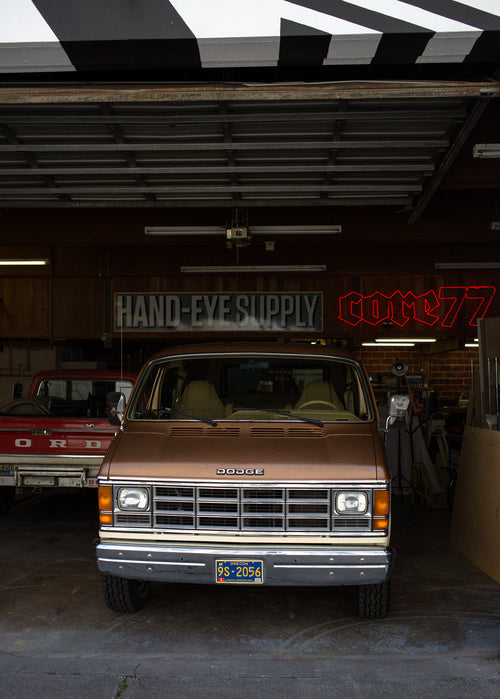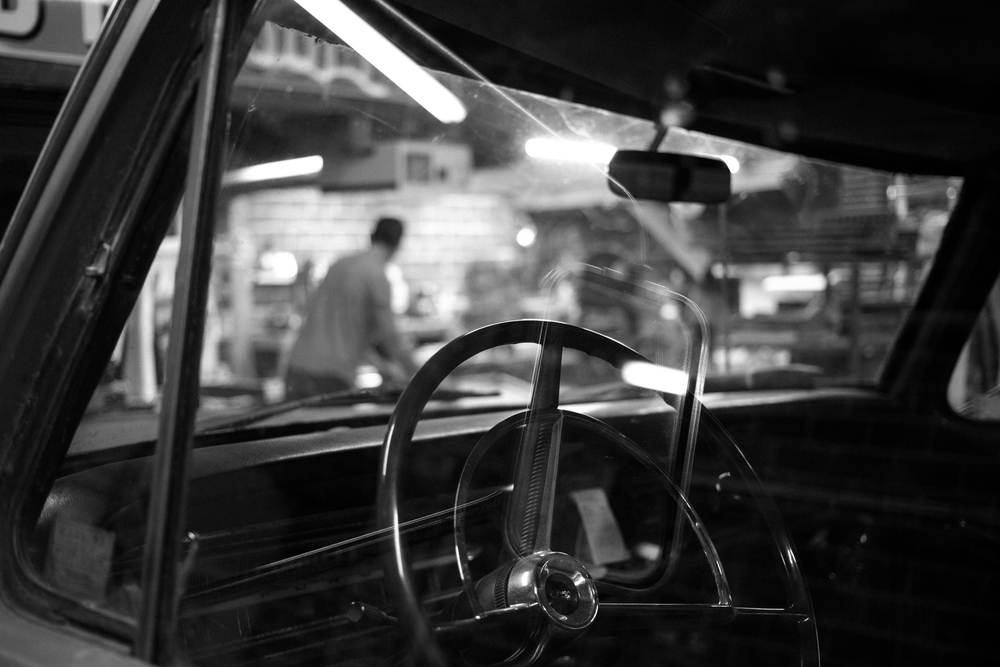The Glisan Garage & The Things Within
Posted on 09 July 2015

Most folks miss that there's more to Hand-Eye Supply than our retail space. This little business is actually comprised of two buildings, our Broadway facing store, and our Glisan facing workshop, creatively named The Glisan Garage. The buildings form an L in the middle of the block, with their facades around the corner from each other. The two buildings were not initially conjoined, having been built a year apart from each other. The retail space was built in 1920 as West Side Cycles, an early motorcycle shop, and the basement was the clubhouse of the Flying 15 Motorcycle Club. The workshop was put up a year later to house the Buck Ambulance Company workshop and dispatch center. Buck was - shockingly - the first ambulance company to carry first aid kits, transforming ambulances from meat wagons into mobile hospitals. They were also the first to carry defibrillators. It’s easy to imagine that many lives were saved out of our little workshop.
By the time we purchased the buildings from the previous owners, Johnson Restaurant Supply, the two buildings had been connected. The retail space was in need of quite a bit of work in order for us to move our retail shop in. Drop ceilings needed to be removed, dirty carpet ripped up, stairs had to be relocated, sheetrock replaced, a new floor laid down, and many more projects lay ahead of us. As plans for the space took shape, I was asked by our fearless leader Eric if I could put together a multipurpose workshop in the Glisan Garage on a small budget, where we could do the modifications and buildout for the Broadway store.

I jumped at the opportunity to buy a bunch of antique wood shop machines and build my dream workshop. I was on a tight deadline to have the workshop up and running, so I chose vintage Delta Rockwell machines as they are readily available and are great tools for the money. Our oldest (and my favorite) machine is our 1945 Delta band saw, which deserves a write up of its own. Our woodworking workbench was Eric's grandpa's, and is so good lookin’ it could be sold at an "industrial antique" store for programmers to eat dinner on.
We did the full store buildout out of the Glisan Garage, from laying the floors to rebuilding an office loft and enormous modular shelving. Now the Garage is mostly used for fixture building and for personal projects, open to Hand-Eye employees in the off hours.

The most recent off-hours project was a particularly fun one. A month before friends of the shop, photographer Ben Sellon and super producer Katie Reardon were set to get hitched, they approached me about helping to convert their 1987 Dodge Ram Van into a mobile honeymoon unit, to use on a great southwestern adventure starting right after their wedding. The design requirements were that it needed to sleep two comfortably, be able to fold out of the way for van hangouts, and be easily removable from the van for non-camping times. I agreed to design something good - I’ll always jump at the opportunity to help hooptify an old car.

My main inspiration was the Westfalia "camping box”, available as an option in VW busses during the 1950's. The camping box was an all inclusive camping contraption in a dresser-like box that included storage, a fold out bed, and a wash basin. Being that I was working on a pretty strict timeline, I had to make it a bit more mechanically simple. I also wanted to make it a functional piece of furniture outside of the van. Ben and Katie needed to be able to easily maneuver it in and out of the van, so weight would also need to be kept to a minimum. In the end, I decided to base it more the 1960's style Westfalia beds, having it fold out from the rear of the van. It would be a simple box with the bed/couch mechanism on top and storage access from the front. And for good looks it would have the appearance of an old fashioned steamer trunk.

The box was made from masonite faced plywood with a 2x2" pine frame. The box was painted and a protective (and fancy) edging was added with Herman Oak english bridle leather, soaked in warm water for a minute or two then formed to the box and fixed with nails. Luggage corners were used to protect the edges and give it a true steamer trunk feel. I welded up a steel frame for the bed with three sections, one for a rear bench, one for the main couch seat, and one for the couch back that folded down for the bed. More masonite ply was attached to these frames. A mechanism was made for flipping the couch down into Bed Mode. Ben and Katie sourced some super dense upholstery foam and sewed up some covers out of canvas.


We jammed the whole contraption together on the night before they took off on their journey. We were up into the wee hours eating cheeseburgers and figuring out how to get the folding mechanism to cooperate with the thick foam pads. After much trial and error it all seemed to come together, and I bid them goodnight and happy travels. After a month of rambling around the southwest, the newlyweds wandered back to Portland. I was thrilled to hear that the bed contraption had served them well, helping to make their van a functional mobile home unit. I hope they get plenty more milage out of the beast. More projects like these will be coming soon. There’s usually something interesting afoot.


All photos courtesy of Ben Sellon.